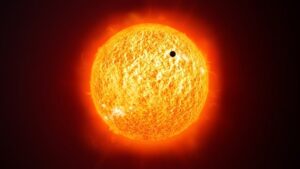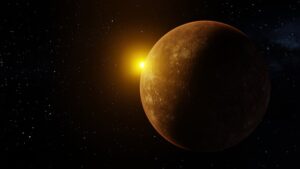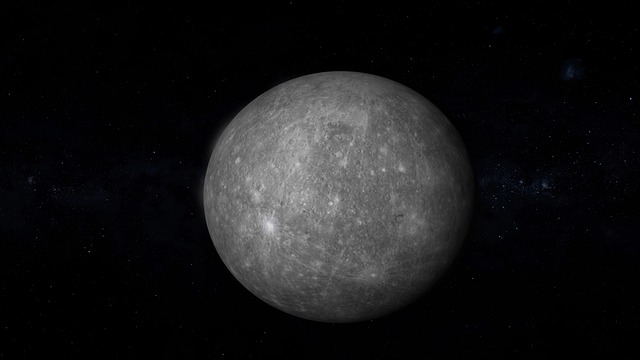Mercury is the smallest planet in our solar system and the first planet from the sun. It is only slightly larger than Earth’s moon and has a diameter of approximately 3,032 miles (4,880 kilometers). Despite its small size, Mercury is a fascinating planet that has captured the imagination of astronomers and space enthusiasts for centuries.
Mercury’s surface is covered in craters, valleys, and cliffs, which are the result of billions of years of impact from comets and asteroids. The planet’s surface is also marked by vast plains and long ridges, which suggest that the planet has undergone significant geological activity in the past.
One of the most remarkable features of Mercury is its extremely elliptical orbit around the sun. This means that the planet’s distance from the sun varies greatly over the course of its year, which lasts just 88 Earth days. Additionally, Mercury rotates very slowly on its axis, which means that one day on Mercury lasts 176 Earth days.
Despite its close proximity to the sun, Mercury’s surface temperature is highly variable, ranging from 800 degrees Fahrenheit (430 degrees Celsius) during the day to -290 degrees Fahrenheit (-180 degrees Celsius) at night. This is due to the lack of a significant atmosphere to retain heat, as well as the planet’s slow rotation.
Mercury’s small size and close proximity to the sun make it a challenging planet to study, but recent advances in technology have allowed scientists to learn more about the planet than ever before. NASA’s Messenger spacecraft orbited Mercury from 2011 to 2015, gathering data and images that have provided new insights into the planet’s geology, geophysics, and magnetic field.
How far mercury is from earth and it is cool or hot planet?
The average distance between the Earth and the Sun is 93 million miles (149.6 million kilometers).
The Earth-Sun distance is known as an astronomical unit (AU), and it is used as a standard of measurement for distances within our solar system. One AU is defined as the average distance between the Earth and the Sun, and it is used to compare distances between planets, asteroids, and other objects in our solar system.
As the Earth orbits the Sun, the Earth-Sun distance varies slightly due to the elliptical shape of Earth’s orbit. At its closest point to the Sun, called perihelion, the Earth-Sun distance is approximately 91 million miles (147 million kilometers), while at its farthest point, called aphelion, the Earth-Sun distance is about 94 million miles (152 million kilometers).
Mercury is both cool and hot, The temperature on Mercury varies greatly depending on the planet’s location in its orbit and the time of day. During the day, temperatures on the surface can reach up to 800 degrees Fahrenheit (430 degrees Celsius) in the sun-facing regions, while nighttime temperatures can drop to -290 degrees Fahrenheit (-180 degrees Celsius) in the shadowed regions. This large temperature variation is due to the lack of a significant atmosphere to retain heat and the planet’s slow rotation, which allows the sun-facing side to become extremely hot and the shadowed side to become extremely cold.
Mercury’s average surface temperature is about 167 degrees Fahrenheit (75 degrees Celsius), which is much hotter than any other planet in our solar system. The high temperatures on Mercury are due to the planet’s close proximity to the sun, which causes it to receive more sunlight per square inch than any other planet in our solar system.
Despite the extreme temperatures on Mercury, there are areas near the poles that are in permanent shadow and are much colder. These regions are thought to contain water ice, which could provide valuable resources for future exploration missions.
is there any effect of mercury planet on earth?
Mercury has no direct effect on the Earth. As the smallest planet in our solar system, Mercury’s gravitational influence on the Earth is negligible compared to that of other planets, such as Jupiter and Saturn.
However, like all the planets in our solar system, Mercury does contribute to the overall gravitational balance of the Sun’s system, and its presence helps to shape the orbits of other planets, including Earth. This, in turn, helps to stabilize the solar system and prevent planets from colliding or being ejected from their orbits.
Mercury also provides valuable scientific information about the formation and evolution of our solar system. By studying Mercury’s surface features, magnetic field, and composition, scientists can gain new insights into the processes that shaped our solar system, as well as the conditions that might be present on other rocky exoplanets.

How small is mercury planet?
Compared to Earth, Mercury is significantly smaller. Mercury has a diameter of approximately 3,032 miles (4,880 kilometres), which is less than half the size of Earth’s diameter of 7,917 miles (12,742 kilometres). Mercury is also much less massive than Earth, with a total mass that is just 5.5% of Earth’s mass.
Despite its small size, Mercury is a fascinating planet that provides valuable information about the formation and evolution of our solar system. Its surface is covered in craters, valleys, and cliffs, which offer clues about the planet’s history of bombardment from comets and asteroids. Additionally, its magnetic field and thin atmosphere provide important information about the planet’s internal structure and the processes that shaped its development.
Is it a liveable place?
Mercury is not currently considered a liveable planet, and it is unlikely to become one in the near future. The planet’s close proximity to the Sun means that it is subjected to intense solar radiation and extreme temperature variations, with temperatures reaching up to 800 degrees Fahrenheit (430 degrees Celsius) in the sun-facing regions and dropping to -290 degrees Fahrenheit (-180 degrees Celsius) in the shadowed regions.
Additionally, Mercury has a thin atmosphere and no magnetic field, which means that it provides little protection from the harmful effects of solar radiation and cosmic rays. These harsh conditions make it extremely challenging for any known form of life to survive on the planet’s surface.
That being said, it is possible that there could be subsurface water or ice on Mercury, which might provide a more hospitable environment for future exploration missions. Additionally, advances in technology and our understanding of life’s ability to survive in extreme environments could lead to new discoveries and a better understanding of the potential for life on Mercury in the future.
Mercury planet core? What’s inside?
The core of Mercury makes up a large portion of the planet, estimated to be around 85% of its total volume. It is believed to be composed mainly of iron, with some nickel and lighter elements, such as sulfur and silicon. The exact composition of the core is still not well understood, as there have been few direct observations of the planet’s interior. However, scientists have used data from space missions and computer models to gain insight into the nature of Mercury’s core and the materials it likely contains.
There are few comparisons with earth’s core:
- Both Earth and Mercury have a metallic core, primarily composed of iron and nickel, with some lighter elements such as sulfur and silicon.
- Both cores are thought to have been partially liquid in the past, with Earth’s outer core still being partially molten.
- Earth’s core is much larger than Mercury’s relative to the size of the planet. This is because Earth is much larger overall, but also because Earth has a higher concentration of heavy elements, which tend to sink to the center of the planet.
- The inner core of Earth is solid, while the core of Mercury is thought to be entirely liquid. This difference is likely due to the difference in size between the two planets, with Earth’s larger size allowing for the generation of enough heat to cause its inner core to solidify.
- Earth’s magnetic field is much stronger than Mercury’s, which is thought to be due to the motion of liquid metal in Earth’s core. This magnetic field helps to protect the planet from the harmful effects of the solar wind.

Mercury importance in mythology?
In mythology, Mercury (known as Hermes in Greek mythology) was considered an important deity and played a significant role in many ancient cultures.
In Roman mythology, Mercury was considered the god of commerce, messenger of the gods, and patron of thieves and merchants. He was often depicted as a young man with wings on his heels and a caduceus (a staff with two snakes) in his hand.
In Greek mythology, Hermes was known for his speed and agility, serving as the messenger of the gods and a conductor of souls to the underworld. He was also associated with commerce and was believed to protect merchants and travellers.
In both cultures, Mercury/Hermes was revered as a trickster, known for his wit and cunning. He was also considered a god of boundaries and was associated with crossroads, which were believed to be sacred places where the barriers between the physical world and the underworld were thin.
Mercury’s importance in mythology extends beyond the Roman and Greek cultures and can also be seen in ancient Egyptian, Etruscan, and Hindu cultures, among others. In these cultures, Mercury was associated with similar attributes, such as commerce, speed, and communication.
Mercury’s significance in mythology reflects the importance of commerce, communication, and transportation in ancient societies, as well as the reverence for wit, cunning, and trickery.
Finally…
Mercury played an important role in ancient mythology as a deity associated with commerce, communication, transportation, and boundaries. He was revered for his wit and cunning, serving as the messenger of the gods and a patron of merchants and thieves. Mercury’s significance in mythology reflects the cultural values and beliefs of ancient societies, highlighting the importance of commerce, communication, and transportation, as well as wit and cunning. Mercury continues to be an important figure in mythology and continues to be remembered and studied today.
